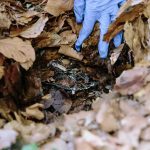Scientists discover pink sea anemone that breaks nature’s rules while partnering with hermit crabs

Japanese researchers have discovered a remarkable new species of sea anemone that challenges fundamental principles of biology while demonstrating one of nature’s most elegant partnerships. The pale pink anemone, scientifically named Paracalliactis tsukisome, was found living exclusively on the shells of hermit crabs in the deep waters off Japan’s coast.
What makes this discovery extraordinary is that the anemone breaks one of nature’s most basic design rules. Unlike typical sea anemones that display radial symmetry—like a pie that can be sliced evenly in multiple directions—this species has evolved an asymmetric, snail-like body structure. This adaptation is “extremely rare in evolutionary terms,” according to lead researcher Akihiro Yoshikawa from Japan’s National Museum of Nature and Science.
The partnership between these anemones and hermit crabs (Oncopagurus monstrosus) represents a perfect example of mutualism, where both species benefit. The anemones consistently attach themselves near the opening of hermit crab shells at depths of 630 to 1,542 feet, all facing the same direction with what researchers describe as a “basic sense of orientation.” Using 3D CT imaging on 36 specimens collected between 2017 and 2024, scientists found that the anemones feed partly on their host’s waste and surrounding organic particles.
This discovery not only reveals a new species but also provides valuable insights into how simple animals perceive spatial orientation and develop body asymmetry—offering scientists a living model to study early evolutionary adaptations in marine ecosystems.
This article was written by the EnviroLink Editors as a summary of an article from: Mongabay







